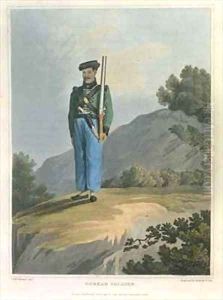Fitzclarence, George Augustus Paintings
George Augustus Frederick Fitzclarence, 1st Earl of Munster, was not primarily known as an artist; he was a British nobleman, soldier, and the eldest illegitimate son of William IV of the United Kingdom (before William's accession to the throne) and his long-time mistress Dorothea Jordan, a notable actress of the time. Fitzclarence was born on January 29, 1794, and his early life was marked by his father's attempts to provide for him and his siblings.
Fitzclarence followed a military career, serving in the Peninsular War under the Duke of Wellington and later achieving the rank of Major-General. His military service was distinguished, and he received several honours and awards for his conduct.
Beyond his military career, Fitzclarence did have connections to the arts through his family. The Georgian era, during which he lived, was a significant period in British art, literature, and theatre. His mother, Dorothea Jordan, was a well-known figure in the theatrical world, and it is likely that Fitzclarence would have been exposed to the arts and cultural figures of the time through her influence.
As for his personal legacy, Fitzclarence was created Earl of Munster in 1831. His personal life, however, was marked by difficulties, including financial troubles and mental health issues. He authored a book, 'Journal of a Route Across India, Through Egypt to England,' detailing his experiences during his travels in the East, which reflects his interest in the broader world, if not in the arts directly. George Augustus Frederick Fitzclarence, 1st Earl of Munster, died by suicide on March 20, 1842.
While Fitzclarence's biography does not reflect the typical career of an artist, his noble birth and military service made him a significant figure in his era, and his connections to the cultural milieu of the time through his family ties provide a secondary association with the arts of the period.


